Aging Population and Chronic Diseases
The aging population and the rising prevalence of chronic diseases are significant factors influencing the Minimally Invasive Devices Market. As the global population ages, the incidence of age-related conditions such as cardiovascular diseases, diabetes, and orthopedic disorders increases. This demographic shift is expected to drive the demand for minimally invasive surgical interventions, as older patients often prefer less invasive options that facilitate quicker recovery. Reports indicate that by 2030, the number of individuals aged 65 and older will reach approximately 1.5 billion, further amplifying the need for effective medical solutions. Consequently, the Minimally Invasive Devices Market is likely to experience substantial growth as healthcare systems adapt to meet the needs of this demographic.
Technological Innovations in Device Design
Technological innovations play a crucial role in shaping the Minimally Invasive Devices Market. The development of advanced materials, robotics, and imaging technologies has led to the creation of more effective and precise devices. For instance, the integration of robotic-assisted surgical systems has revolutionized surgical procedures, allowing for greater precision and control. The market for robotic surgical systems alone is anticipated to exceed USD 20 billion by 2025. Furthermore, innovations in imaging technologies, such as 3D visualization and augmented reality, enhance the surgeon's ability to perform complex procedures with minimal invasiveness. These technological advancements not only improve patient outcomes but also drive the demand for new devices, thereby contributing to the growth of the Minimally Invasive Devices Market.
Increased Focus on Patient Safety and Outcomes
The heightened focus on patient safety and outcomes is a pivotal driver of the Minimally Invasive Devices Market. Healthcare providers are increasingly prioritizing techniques that minimize risks and enhance recovery experiences for patients. Minimally invasive procedures are associated with lower rates of infection, reduced blood loss, and quicker recovery times, which align with the growing emphasis on patient-centered care. As hospitals and clinics strive to improve their quality of care metrics, the demand for devices that facilitate these procedures is likely to rise. This trend is further supported by regulatory bodies advocating for safer surgical practices, thereby reinforcing the growth trajectory of the Minimally Invasive Devices Market.
Rising Demand for Minimally Invasive Procedures
The increasing preference for minimally invasive procedures is a primary driver of the Minimally Invasive Devices Market. Patients are increasingly opting for these procedures due to their associated benefits, such as reduced recovery times, lower risk of complications, and minimal scarring. According to recent data, the market for minimally invasive surgical devices is projected to reach approximately USD 50 billion by 2026, reflecting a compound annual growth rate of around 8%. This trend is further fueled by advancements in surgical techniques and technologies, which enhance the efficacy and safety of these procedures. As healthcare providers continue to adopt minimally invasive methods, the demand for specialized devices is expected to grow, thereby propelling the Minimally Invasive Devices Market forward.
Cost-Effectiveness of Minimally Invasive Procedures
The cost-effectiveness of minimally invasive procedures serves as a compelling driver for the Minimally Invasive Devices Market. These procedures typically result in shorter hospital stays, reduced need for postoperative care, and lower overall healthcare costs. Studies have shown that hospitals can save up to 30% on costs associated with surgical procedures when utilizing minimally invasive techniques. As healthcare providers seek to optimize resource allocation and improve patient outcomes, the adoption of minimally invasive devices becomes increasingly attractive. This economic advantage not only benefits healthcare systems but also encourages patients to choose these options, thereby fostering growth within the Minimally Invasive Devices Market.



















Leave a Comment